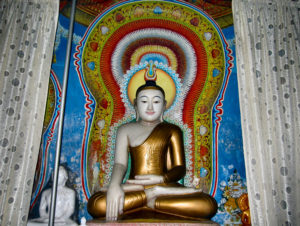Introduction to BUDDHISM

I don’t know what Buddhism really is- a religion? Or preaching! But what I know, is that it’s the art of living life. It’s finding the purpose in your life. It’s not just about existing but, living. And to live is beyond everything. Which is why Buddha asked one to experience and practice this art himself and thus conclude that Buddhism is beyond any religion.
Buddhism is known to have its roots from the iron age of India around the middle first millennium BCE when the Upanishads and the Sramanic traditions were making their way into the Historical Vedic religion. This was the period when Brahmanism, better known as Hinduism influenced every mind in Indian society. While Hinduism taught one to worship gods and deities; practice and perform religious rituals, Buddhism preached to people to worship themselves and to discover one’s true best form which would attain them salvation.
It was at the time of the Mauryan empire that Buddhism established itself as a religion, under the rule of Asoka who was an ardent follower of its practices. Gautama Buddha (Siddhartha) was extremely moved to see all the adversities and innate sufferings of life that every living being had to face, and that these sufferings would follow one in his every birth due to reincarnation. So Buddha shunned his materialistic life giving up everything and set out on a quest in search of freedom from these sufferings. It was not until he reached Bodh Gaya and sat under the Bodhi tree (Fiscus religiosa) meditating, that he finally discovers that the answers to life and death which he was found outside, actually lay in his inside. He attained enlightenment through an insight into his learnings of Karma and laid down the Four Noble Truths and the Eightfold Path.
Through the preaching of Buddhism, Buddha wanted people to engulf the morals of truth, empathy, wisdom, compassion, and love not only towards humans but every living being. According to him, by giving up on all evil desires one could win the four noble truths of life which were the different stages of sufferings.
Buddhism originated in India but slowly spread to other countries including China, Srilanka, Bhutan, Japan, Tibet, Korea etc. Unlike in India where multiple religions exist with Hinduism being dominant, these countries have adopted Buddhism as their only religion and it is much respected by everyone and supported by the government too. It has contributed a lot in each sphere of humanity and life.
Buddhism: Development of Language and Literature
Buddhism is divided into many branches. Theravada Buddhism uses Pali as it’s the main language with its scriptures written and existing in the same language and are expected to be read in this original language. The mantras exist in Sanskrit which was the original language in which Buddha preached. But Mahayana Buddhism makes little use of Sanskrit language. Buddhavacana “word of the Buddha” include teachings and works of Buddha which are also known as “Sutras”, while other texts being Shashtras and Abhidharma. Other canonical texts like Sutta Pitaka, Vinaya Pitaka, and Abhidhamma Pitaka were also written in Pali language.
Simple Religion
Buddhism was subtle to be followed and was easily accessible free of complexities of Brahmin culture, traditions, and rituals. People made it their own language across the globe because of its real yet simple conclusions.
Opposition to Caste System
Buddha strongly refused to follow the caste system and its cruelties and inequality towards people established by the Hindus. Later on, Ambedkar also adopted it and welcomed every individual to accept it who didn’t find a peaceful life being a part of the Hindu religion.
Ethical Values
Buddhism taught people to cultivate simple values like truth, nonviolence, brotherhood, etc. Humanity should be the greatest of all only then will we be able to build up an equal and healthy society.
Impact on Hinduism
When Mahayana started worshipping the image of Buddha, it influenced Hindus to worship their different gods. However, they found performing their rituals tiresome which is why some Hindus started praying through meditation. Some Hindus even converted to Buddhists.
Role in Art and Architecture
Asoka influenced rock art and architecture. Many stupas and pillars were constructed out of a rock, like the Sanchi Stupa in Sanchi which is a Buddhist complex. Buddhist monasteries or viharas, prayer halls, and shrines are known as chaitya grihas were also built. An excellent example is Nalanda, an acclaimed Mahavihara in Bihar.
Buddhist carvings of Ajanta and Ellora caves were also influenced by Buddha.
Brotherhood and Unity
It was Asoka who took the initiative to spread brotherhood universally through the genesis of. He even asked his own son Mahendra and daughter Sanghmitra to spread its teachings to Srilanka. People would attend and listen to the monks which brought people of different regions and religions together which became a unifying factor. Till today monks like Dalai Lama preach the religion throughout the world.
Historical Influence
It motivated and inspired Mahatma Gandhi to adopt the path of ahimsa when he started his struggle for independence. It attracted Kushan king Kanishka to embrace Buddhism for peace and consolation being regretful of his past deeds. Harshvardhan didn’t stay behind in doing this too. The land of Kalinga also changed from Chandasoka to Dharmasoka.
Upliftment of Women
Buddha respected and asked everyone individual to respect the other irrespective of their caste, gender or social status. He was very compassionate towards all including women, children or even animals. He believed in equal rights for the widows and nuns and was especially humble towards the old. He disapproved of the inequality between men and women. Under his shadow, women started coming to the forefront and it improved their position in the society.
We cannot be thankful enough to Buddha to give us this path which is a way to replenish our souls and discover the spirituality in everything despite the nothingness and emptiness (sunyata) that exists in our lives.
Literature Student at Delhi University!
